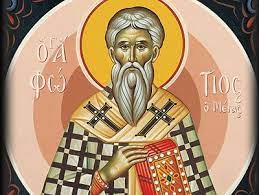
Commemorated on February 6
That rather complicated title above is fitting for a man who led an extremely complicated life.
Poor Saint Photios. What he wanted was a scholarly, contemplative, perhaps monastic life. What he actually got was a lot of trouble. Caught up against his will into the midst of great turmoil in the Church and in the politics of imperial Constantinople, Saint Photios did his duty and much more. Quite an amazing man.
As I researched Saint Photios, I soon concluded I wasn’t up to giving you the full story of his life, and certainly not in one short Post. Therefore let me say just a little about him, then concentrate on the falsely-called Photian Schism and the claim of the Papacy to have absolute jurisdictional authority over all Christians.
At the end of this Post I’ve suggested several websites where you can get the story of Saint Photios in full, and understand better why he is called Saint Photios the Great. In Eastern Orthodoxy, that is. On the official Roman Catholic calendar for February 6, many holy men and women are listed – not one of whom is Saint Photios, Patriarch of Constantinople.
A very short Summary of the Life of Saint Photios
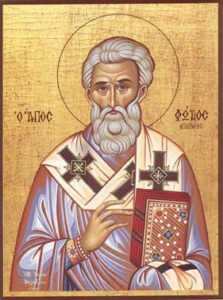
Photios was born about the year 820 to parents who had high connections in Constantinople, but who were persecuted (some say martyred) for defending the holy icons against the iconoclasts. Young Photios must have been exiled with them.
However (skipping the story of his earlier life) in time when he was yet a layman only about thirty-eight years of age, he was pressured to become Patriarch of Constantinople. He accepted this calling unwillingly. In five days he was ordained subdeacon, deacon, presbyter, and bishop and was then appointed Patriarch! One of his many activities was to correct the error of Pope Nicholas of Rome who was attempting to depose him. He in return excommunicated the Pope for falsely interfering in the business of Eastern Orthodoxy where he had no jurisdiction or authority.
In the Roman Catholic view Saint Photios was wickedly refusing to obey the Pope and was therefore a schismatic. That is why in the West this is called the “Photian Schism”. In the Orthodox view, Saint Photios was valiantly defending the Orthodox Faith against the novelties of universal Papal jurisdiction and also some Latin deviations from the Orthodox Faith. We’ll say more about this in a moment.
Saint Photios was known for his calm demeanor and his academic brilliance. His knowledge was vast: theology, history, grammar, philosophy, law, the natural sciences, and medicine. Saint Photios was author of many books and treatises on many subjects. Even while he was patriarch, he taught eager young students at his home, which became a center of learning.
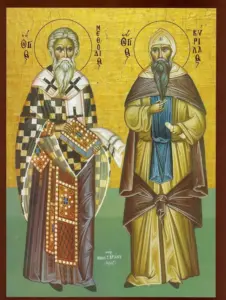
You probably know how Saints Cyril and Methodius, at the request of the Prince of Moravia, went north as missionaries into Slavic lands. What you may not know is that they were nephews of Saint Photios, and he was the one who sent them. He later blessed Saint Cyril in his work of developing an alphabet for the Slavic people. As a result of their work, in time most Slavic peoples became Orthodox, and their written language is called “Cyrillic” to this day.
The Schism between the sees of Rome and Constantinople was short-lived, lasting only from 863–867. It was settled on Orthodox terms, without compromise to the Orthodox Faith.
Because of Byzantine intrigues *, Saint Photios was twice sent into exile. Once he was restored as Patriarch. The second time he was not. He died in exile in Armenia on February 6, 893.
- There is a reason why in popular usage the word “byzantine” means “convoluted, involved, knotty, tangled, tortuous complex, and sometimes devious”.
Quickly he was reverenced as a saint, indeed as Saint Photios the Great. In the Orthodox Church he is considered one of the greatest of Patriarchs, perhaps equal to Saint John Chrysostom.
As I said above, for the details (which are many and fascinating) of Saint Photios’ life, please go to the sites listed at the conclusion of this Post.
Papal Supremacy and the (not) Photian Schism
From the Orthodox point of view, perhaps this should be called the first “Papal Schism”, the precursor of the Great Schism of 1054, which in fact was only the beginning of the division between Rome and Orthodoxy. But let’s not go into the history of that now.
Here I want to look not so much at the events surrounding this first break between Rome and Constantinople, but rather at the history, theories and principles which lay behind it.
Roman Catholic authors, especially in past times, have written scurrilous accounts about how Patriarch Photios wickedly refused to accept Papal authority.
Orthodox writers to this day often write about how Pope Nicholas wickedly tried to impose Papal authority on Orthodoxy.
For myself, I’m not going to join the argument about who was the “wickeder”. I think both were acting according to the theological principles they believed in, which they had received from those who had gone before them.
Nor do I believe that, sometime in the past, Pope “Somebody” woke up one morning and said to himself: “I know what I’ll do. I’ll invent the principle of universal Papal jurisdiction and destroy the unity of Christ’s One Holy Catholic and Apostolic Church”.
I believe (doubt this, if you wish) that these divisions were caused chiefly by the differing histories and social situations that had developed between Rome and the East.
Now, in the beginning there is no doubt that the Church of Rome was reverenced both East and West as the prime see of the Church. Saint Peter was chief of the Apostles, first in every way in the New Testament. Peter was the rock on which Christ built His Church. Peter had settled in Rome, was founder of the Church in Rome, and was martyred in Rome. The Church of Rome had “primacy” in the Church, but not in jurisdictional authority. Saint Ignatius in his Letter to the Romans (c. AD 106), famously referred to Rome “presiding in love” over the other churches. I believe that, to this day, Orthodoxy would accept the primacy of the chief Patriarch, the Pope of Rome, not in legal authority and control, but “presiding in love”.
In the beginning the Church, both East and West, functioned on a “conciliar” basis. Beginning with the Apostolic Council, bishops (or their representatives) from the many churches met in Council to decide how best to express the Faith and how the Church should function. There came to be five chief Patriarchates: Rome, Antioch, Alexandria, Constantinople and Jerusalem – all working together in council. The jurisdiction of Rome came to cover all of Western Europe.

In the East the Roman/Byzantine Empire brought peace. The Church could function easily on a conciliar basis, because travel and communication were easy. Nor did Patriarchs need to take on political power. The Empire provided that.
Things were like that in Rome, but only for a while. West of the Adriatic, beginning in the late Fourth Century large numbers of Germanic peoples *, Huns, Avars, Slavs and others moved into the Western Roman Empire. In the year 476 the city of Rome fell. There was no longer any common civil authority. Travel between East and West, both overland and by sea, became very difficult – and therefore communication and common understanding between Rome and the East became difficult, especially so because the common ecclesiastical language of the West was Latin, but in the East it was Greek.
- Some of my ancestors. Sorry.
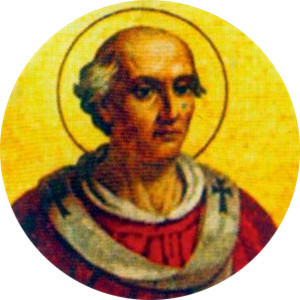
Now, in the West there was one “Apostolic See”, one church alone founded by an Apostle. As things in society and in the Church became ever more tumultuous, people turned ever more to their one “Apostolic See”. Pope Gelasius (492-496) declared that “The see of blessed Peter the Apostle has the right to unbind what has been bound by sentences of any bishops whatever, in that it has the right to judge the whole Church. Neither is it lawful for anyone to judge its judgment, seeing that canons have willed that it might be appealed to from any part of the world, but that no one may be allowed to appeal from it.” Pope Gregory “the Great” (590-604), an excellent refoermer and administrator is considered founder ot the “medieval Papacy” which exercised both spiritual and secular power. What else were the Popes to do? All of their Patriarchate was a disaster area. The Caesars had moved to Constantinople centuries before. The Roman Senate was defunct. Somebody had to be in charge.
So, acting chiefly in isolation from the Churches in the East, the Church of Rome naturally gathered ever more power to itself, was even open to making doctrinal decisions by itself.
In the above I have wildly oversimplified and left out about 99% of the story. However, you get the picture.
Meanwhile, back in the East, neither society nor the Church had changed much. The Eastern Patriarchs had no issue with how the Roman Church ran its own business, except in universally-held doctrine and practice. When Roman documents regarding universal Papal jurisdiction went East, the Orthodox either ignored them or misunderstood them or… who knows? Anyway they didn’t take it seriously. They understood that in early times people from the East had appealed to Rome. After all, Rome had a past history of staying almost consistently Orthodox in doctrine, while the East was sometimes crawling with heretics. References to “Roman primacy” they took to refer to “primacy in love”, not “primacy in jurisdiction and authority”. The East understood that the Rock on which Christ built His Church was Peter’s Faith, not on the person of Peter himself, and certainly not on Peter’s ecclesiastical descendants. When did Christ ever command that? No problem.
… until suddenly in the year 863 Pope Nicholas tried to remove Photios, the Patriarch of Constantinople – believing he had the authority to do so. And for the first time, the Orthodox East woke up and said: “Wait a minute, fellah. You have no such authority. You can rule your own Western bishops any way you want, but stay out of the East. And, by the way, we strongly object to your playing games with the original and ecumenical Creed.” (I paraphase a bit here.)
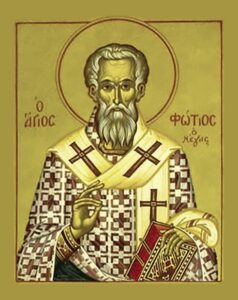
Saint Photios, excommunicating Nicholas in return, wrote to him, “Nothing is dearer than the Truth.” In the same letter he noted, “It is truly necessary that we observe all things, but above all, that which pertains to matters of Faith, in which but a small deviation represents a deadly sin.”
This was the precursor to the Great Schism of 1054 between Rome and Constantinople, then a bit later affecting the remainder of the Orthodox East, which endures to this day.
In the articles below, you can read the story of what came next and how it all turned out. I included one Roman Catholic site, so you can read for yourself their traditional opposite opinion (to put it mildly!) of Saint Photios.
Hieromonk Makarios (see below) wrote: “The calumnies spread about St. Photios …, accepted for centuries by historians and Western apologists alike without serious examination, made him responsible for all the discord and division which paved the way for the Great Schism of 1054. Fortunately, the researchers of modern Roman Catholic historians (notably F. Dvornik, The Photian Schism, Cambridge 1970) have reestablished the facts of the matter, which in all respects corroborate the tradition of the Orthodox Faith.”
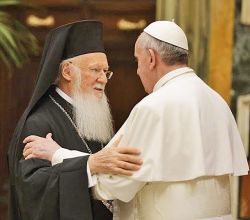
Can the Schism ever be healed? Not in my lifetime, I’m sure, and almost certainly not in yours. It took us hundreds of years to get into this situation, and there will be no quick, easy way out of it. However, scholars on both sides are taking a more irenic view of each other. Popes and Patriarchs of Constantinople have met. In 1965, Pope Paul VI and Patriarch Athenagoras I lifted the longstanding mutual excommunication decrees * made by their respective churches.
- Does this mean Orthodox and Roman Catholics may receive the Eucharist in each others’ Churches? Oddly enough, but definitely: No. So don’t you going to try to do so, even if some Roman Catholic priests break their own rules and invite you to do it.
Here are the sites I mentioned above, if you want to go into the interesting details and explanations of the life of Saint Photios:
1 Orthodox Wiki: https://orthodoxwiki.org/Photius_the_Great
2 This is a long but interesting and well written: https://orthochristian.com/97929.html
3 The Synaxarion for Saint Photios, by Hieromonk Makarios of Simonopetra Monastery on Mount Athos: https://www.johnsanidopoulos.com/2011/02/saint-photios-great-patriarch-of.html
4 from the Greek Archdiocese of Pittsburgh: https://www.pittsburgh.goarch.org/st-photios-the-great
5 For contrast you might want to read the life of “Photius” (no “Saint”) from New Advent, a Roman Catholic site which takes, shall we say, a negative (I’d call it scurrilous) view of Saint Photios. . https://www.newadvent.org/cathen/12043b.htm
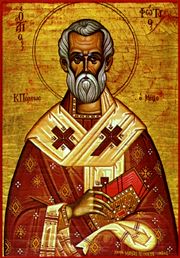
Holy Photios the Great, pray for the unity of all Christians in the Catholic and Apostolic Faith, and for the salvation of our souls.
Next Week: A Twentieth Century Saint – Papa-Nicholas Planas of Athens
Week after Next: The bizarre story of Jesus and the Canaanite Woman
I love the clarity of your writing. Thank you dear Father!
You’re welcome.
In Protestant seminary, we had to read various theologians who wrote in convoluted ways. I decided that if you can’t say it clearly, it means you don’t understand it yourself. Then along came C.S. Lewis and his clarity, whom many theologians despised as a “popularizer”, whom I took as my “role model”.